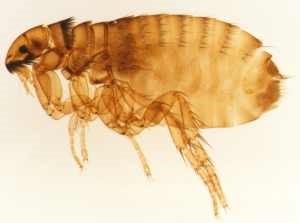Flea Facts
November 10, 2014 – Do fleas exhibit sexual dimorphism (anatomical differences between male and female)? Can you separate the female fleas from the males when you see them? Does it really matter? Yes, yes and YES!
Do the math. Females are egg layers, and after 60 million years on the planet; they’ve perfected their technique. Think somewhere in the neighborhood of 100 eggs per day. At that rate, ten females can fill your house with a 1,000 eggs a day; 7,000 a week, and 28,000 a month. Get the picture? Birds, fish and reptiles are egg laying light weights compared to the flea.
In this day and age it can be challenging to visually distinguish men from women. Elaine on Seinfeld exemplified it by saying, “The women’s body is like a work of art; whereas the man’s body is utilitarian, like a Jeep.” Size, shape, hair style, clothing, walk, voice, or even jewelry are unreliable indicators for humans. Birds make it a little simpler by being colorful (males) versus bland (females). Fleas are the easiest of all – they’re all black in color; but the females are large and the males are small. And that never changes.
The bottom line – If you see large fleas on your dog or cat – you have many more to come. Rule of thumb: If you see one mouse in your house; there are probably 100 more that you don’t see. In the world of fleas; it’s closer to an unseen thousands.
When female fleas are not romancing males and laying eggs; they’re eating and pooping. That rounds out the life of a flea. They need to consume blood to lay their eggs; and they need to poop out the blood to feed their young. Flea eggs are white and oval; whereas poops are black and curly-Q shaped. Eggs and flea feces fall freely to the ground where the eggs hatch into hungry larvae (they look like miniature white caterpillars) that feed on the mouth-watering excrement. How can you tell the difference between black specks of flea blood and garden variety sand or soil? Put them on a white piece of paper and add a drop of water; if they dissolve into a red liquid – it’s flea feces.
So how is the poop of your pet, the poop of their parasites, and the poop of the public all potentially related? Can you say, “Tapeworm?” Tapeworms lay eggs too, but unlike most worms, they encase them in a terminal segment of their body (the size and likeness of a rice grain). Fleas spend a fair amount of their time around the back half of your pet, an inaccessible area of the body, and because of it; flea feces and eggs end up in the pet’s stool. Adult fleas can’t actually “bite,” because they have a siphon for sucking blood (like a mosquito) rather than biting mouth parts, but the larvae are great at biting and eating just about anything they come across, including tapeworm segments. Get the connection?
Flea larvae carry tapeworm eggs through their development to the adult flea. While in the process of normal grooming; dogs or cats accidentally swallow fleas. It happens all the time, especially by barb-tongued cats that swallow nearly 99% of their fleas. Not a real problem (additional insect protein) unless the flea is full of tapeworm eggs. The ingested flea sacrifices its life to give birth to a bunch of blood sucking flatworms. A cycle the worms depend on for their existence. What are the odds you or your child might swallow a flea? Fortunately, low, but improved by unsafe pooper scooping habits, sleeping with your dog or cat, or lack of adequate flea control? Reports suggest that we likely swallow an occasional spider in our sleep. Why not fleas? They come in much higher numbers.
Without appearing totally “anal” about this subject, there’s another important aspect of flea feces that could be considered a dimorphism of defecation. Fleas are “obligate” parasites, which is to say, they live on their host. In a perfect world they would not harm their home; and that is why normal dogs and cats typically do not react to the presence of fleas, i.e. no itching or scratching. They live happily together and both perform normal bodily functions. So what’s the wrench in the works? It starts with an “A” and ends with a “Why.” Allergy literally means “strange disease,” because we don’t know why we, or our pets, have it. It doesn’t do any good for your pet or the flea.
Flea allergy dermatitis (FAD) causes intense itching; resulting in dislodging, maiming and killing of fleas, and discomfort, self mutilation and infection for your pet. Being chased around the body by an endless scourge of chewing and scratching tends to dramatically lower the numbers of fleas and seriously disrupt their bathroom habits. Hence the flea becomes the hunted and the helper. Hunted for the harm it does, and the helper for what it can tell us:
1. You can easily find fleas on normal dogs and cats; while they live happily without harming their skin. You will have a difficult time finding fleas on a flea allergic dog or cat; as the volatile living conditions preclude their survival.
2. Flea poops will appear as curly-Q’s on normal dogs and cats; where the fleas have plenty of time to empty their entire bowels. Flea poops will appear as small fragments (sand grains) on a flea allergic dog or cat; as their eliminating behavior is constantly disrupted.
Summary: The evidence of flea allergy, in dogs and cats, is not the flea; it’s the flea poop.
Take home message: Get rid of the fleas; and all the poop business and tapeworm problems go away with them.

